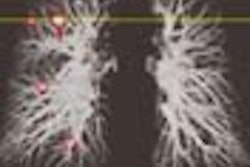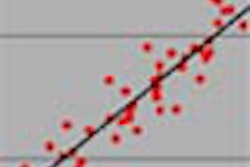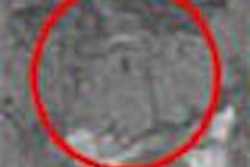The U.S. Department of Homeland Security’s orange alert last month revived the nation’s concerns over terrorist attack, sending many citizens scurrying to the hardware store to stock up on duct tape and plastic sheeting -- all in the hopes of shielding themselves against a bioterrorist attack.
While public fervor over a potential terrorist attack has simmered down of late, the medical imaging community must remain on high alert, according to an article in the latest issue of the American Journal of Roentgenology.
Radiologists will play crucial roles in diagnosing and treating illnesses caused by biological agents, particularly inhalational anthrax, which manifests specific symptoms on chest x-rays and CT scans, wrote Dr. Loren Ketai and colleagues in the AJR review. Ketai is from the University of New Mexico Health Science Center in Albuquerque. The paper’s co-authors hailed from the King Faisal Specialist Hospital and Research Centre in Riyadh, Saudi Arabia and the Instituto Nacional de Enfermedades Virales, Humana in Pergamino, Argentina.
Ketai and colleagues surveyed the existing imaging literature on biologic agents that could be used as weapons, focusing on how diseases caused by infectious agents would manifest after inhalation. Because many of these diseases are uncommon and imaging data are limited, it’s important for radiologists to review what images exist in order to be on the alert, according to Ketai. Although CT scans or chest x-rays of inhalational anthrax will produce unique characteristics, the same cannot be said of other diseases that could be deployed as a form of bioterror, the paper stated (AJR, March 2003, Vol. 180:3, pp. 565-575).
"Anthrax’s radiologic manifestations, striking mediastinal edema, and hemorrhagic adenopathy can by themselves suggest the diagnosis," Ketai further explained in an e-mail to AuntMinnie.com. "Other infectious agents that could be used as biologic weapons cause more nonspecific abnormalities, but radiology findings would be important in the context of a sudden increase of disease in the community."
During the 2001 inhalational anthrax scare, it became clear that chest x-rays and CT scans were effective in diagnosing the disease. At the 2001 RSNA conference in Chicago, Dr. Jeffrey Galvin, chief of chest and mediastinal imaging at the Armed Forces Institute of Pathology in Washington, DC, moderated a special panel that outlined diagnostic criteria for chest x-rays and CT scans of inhalational anthrax.
Characteristics to look for on chest x-rays include a widened mediastinum, bilateral hilar masses, bilateral pleural effusion, and perihilar airspace opacities. For noncontrast routine spiral CT, characteristics include profuse and slightly hyperattenuating paratracheal, AP window; subcarinal, hilar, and azygo-esophageal recess lymphadenopathy; bilateral pleural effusions; bibasilar airspace disease more pronounced on left or right; and thickened peribronchial tissue.
In addition to inhalational anthrax, radiologists could use chest x-rays and CT and MR scans to help diagnose plague, tularemia, viral brain infections like equine encephalitides, and smallpox. Chest x-rays of patients with plague often show bilateral pneumonias, and patients with naturally occurring tularemia present with bronchopneumonia -- usually bilateral -- which may create cavities in lung tissue.
MR and CT can show damage to the central structures of the brain due to equine encephalitis. Although radiology has a limited role in diagnosing smallpox, chest x-rays can catch a mild pulmonary form of the disease (without skin lesions) that manifests in patients who have been vaccinated for the disease and are later exposed to the virus.
Another issue addressed in the AJR review is how healthcare professionals can adequately protect themselves from these diseases. It depends on the illness, according to Ketai. Inhalational anthrax, viral encephalitis, tularemia, Q fever, and some of the hemorrhagic fevers are not easily transmitted between people, but diseases like smallpox present more of a challenge, she explained.
"Smallpox and plague are problematic," Ketai said. "(Smallpox in particular) leads to the question of vaccination for healthcare workers, which becomes a complex public health issue."
Ketai’s article adds to the resources that the radiological community has been compiling since the 2001 terrorist attacks on the World Trade Center in New York City and the Pentagon in Washington, DC. In April of 2002, the Agency for Healthcare Research and Quality, which operates under the U.S. Department of Health and Human Services, launched a Web site to teach hospital-based physicians and nurses how to diagnose and treat rare infections, as well as how to recognize exposures to bioterrorist agents such as anthrax and smallpox. The site offers online courses to emergency department clinicians, including physicians, nurses, radiologists, pathologists, and infection control practitioners.
In June 2002, the American College of Radiology published "Disaster Preparedness for Radiology Professionals: Response to Radiological Terrorism," a guide to help the medical community respond to terrorism. The guide includes information on preparation for a radiation-related emergency; how to handle contaminated patients; and the radiological findings related to agents that may be used as chemical or biological weapons.
In the event of bioterrorist attack, good communication between radiologists, primary care physicians, and public health officials would be crucial for the early identification and treatment of disease caused by biologic weapons, according to Ketai.
"The chance that a civilian radiologist will be involved in the diagnosis and treatment of illness caused by a biologic weapon remains remote," Ketai said. "We should be alert to any cluster of unusual radiologic cases, but otherwise not start entertaining the possibility of rare disease in our practice."
By Kate Madden YeeAuntMinnie.com contributing writer
March 14, 2003
Related Reading
CT spots sentinel pneumonia in 9-11 rescue worker, September 25, 2002
Journal publisher may withhold information deemed useful to terrorists, July 26, 2002
ACR handbook offers anti-terrorism tips, June 13, 2002
CT is the gold standard for inhalation anthrax imaging, November 29, 2001
Chest CT pegs inhalation anthrax at Virginia facility, October 30, 2001
Copyright © 2003 AuntMinnie.com



















